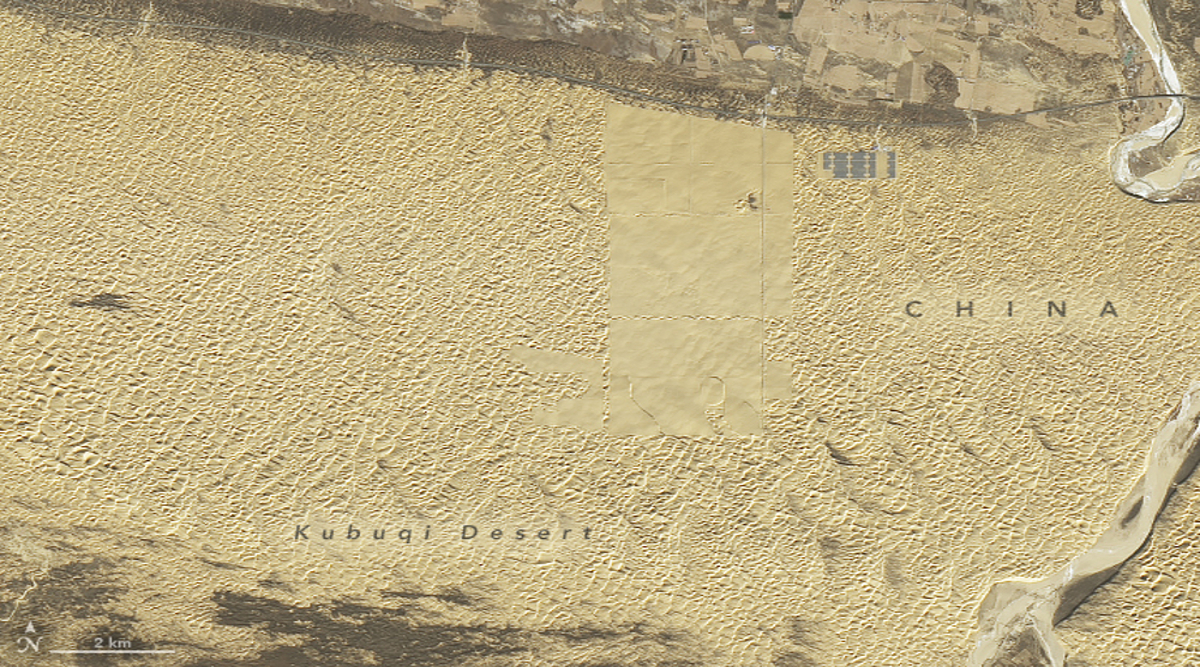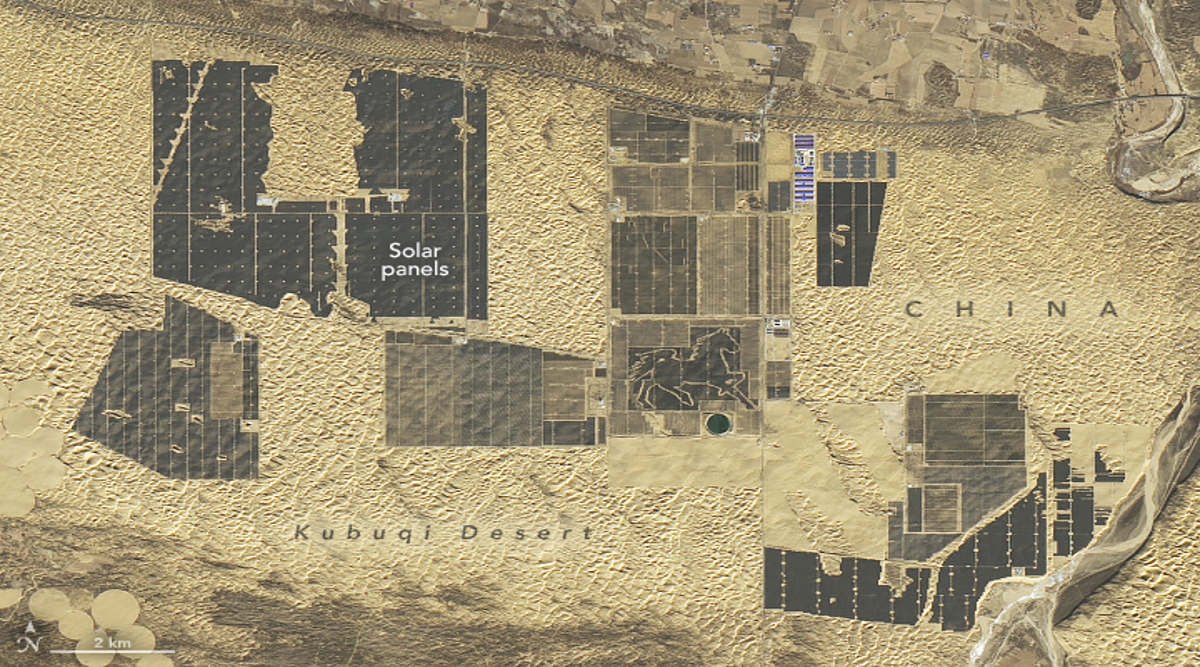
Sign up for daily news updates from CleanTechnica on email. Or follow us on Google News!
Between 2017 and 2023, the operational solar capacity in China increased annually by about 40,000 megawatts. The US, in comparison, added an average of just over 8,000 megawatts per year over the same period, according to NASA Earth Observatory. As of June 2024, China led the world in operating solar farm capacity with 386,875 megawatts, representing about 51% of the global total, according to Global Energy Monitor’s Global Solar Power Tracker. The United States ranked second with 79,364 megawatts (11%), followed by India with 53,114 megawatts (7%).
There are lots of people in the US and other western countries who accuse China of providing massive government incentives to certain industrial sectors — primarily electric cars and solar panels. While it is true that the Chinese government does provide support for those industries — such as access to low interest financing and low cost manufacturing space — there is another component that is often overlooked — economies of scale. Producing 40,000 megawatts of solar panels a year ipso facto means they will be cheaper to produce than they are in a country that produces only 8000 megawatts’ worth of panels. That should be intuitively obvious to anyone who knows a lick about economics.
Now China is putting its shoulder to the wheel to turn the Kubuqi Desert in Inner Mongolia into a vast solar farm 400 kilometers (250 miles) long and 5 kilometers (3 miles) wide. When completed, it will have a maximum generating capacity of 100 gigawatts — enough to power the entire city of Beijing, which currently is home to nearly 22 million people. Chinese officials say they have installed about 5.4 gigawatts of solar capacity so far, according to China Daily. Cameras aboard NASA’s Landsat 8 and 9 satellites captured a pair of images that show the expanding footprint of the components of the vast solar farm — which has been dubbed the Great Solar Wall of China — in December of 2017, and again in December of 2024.


Powering Beijing With Solar
According to China Daily, Beijing consumed 135.8 billion kilowatt-hours (kWh) of electricity in 2023. It’s expected that the Great Solar Wall Of China, once completed, will generate around 180 billion kWh of electricity by 2030. If the energy demands of the capitol city do not increase substantially by 2030, there would be enough solar power available to power not just Beijing, but its surrounding areas as well. The new solar project will far exceed the annual power generation of what today is currently the world’s largest solar farm, also in China, which has a capacity of just over 6 billion kWh per year.
Sandy and mostly devoid of life, the Kubuqi Desert once had a reputation for being a “sea of death.” However, its sunny weather, flat terrain, and proximity to industrial centers make it a perfect location for solar power generation. Panels are being installed in a long, narrow band of dunes just south of the Yellow River between the cities of Baotou and Bayannur. One part of the project is a solar farm that resembles a galloping horse — Junma Solar Power Station — which was completed in 2019 and set a Guinness world record for the largest image made of solar panels. It generates approximately 2 billion kilowatt-hours of electricity each year, enough to meet the yearly electricity needs of 300,000 to 400,000 people. Junma means “fine horse” in Mandarin.
In addition to generating power, planners hope that the installation will have other benefits. They think it may help curb desertification by preventing the movement of dunes and slowing winds. Also, the elevated panels create shade that slows evaporation and may make it easier to grow pasture grasses and other crops beneath them. It also allows room for people and farm equipment to move around freely beneath the panels. An analysis of Landsat data indicates that solar projects have contributed to the greening of deserts in other parts of China in recent years.
Solar For Desert Environments
Solar farms need different technologies depending on the environment where they are installed. For the Kubuqi Desert, planners adopted an innovative approach. The solar panels are mounted 2.5 meters (8.2 feet) above the ground to allow plants to grow and small livestock to graze underneath. The solar panels can reduce groundwater evaporation by 20 to 30% while providing shade from the sun and shelter from the wind, which supports plant growth. With plants and poultry thriving in the shade, this approach yields both economic and ecological benefits.
In some especially arid areas, solar-powered drip irrigation is also being adopted to supply water to green desert landscapes. The nearby city of Ordos — known for its abundant coal resources — has several large coal mines scattered across the Kubuqi Desert. The treated drainage water from the coal mines is channeled from these mines to the solar power base and used to clean the solar panels and water the plants.
To adapt to the challenging conditions of desert environments, innovations in photovoltaic modules have been introduced. The photovoltaic modules use bifacial technology and high efficiency cells that can capture sunlight from both sides. This allows them to take advantage of the high reflectivity of sandy surfaces to boost power generation by approximately 8%. The life span of the modules has also been extended from 25 years to 30 years thanks to the adoption of dual glass encapsulation materials.
China is currently the world’s largest emitter of greenhouse gases. In 2021, it added 10.8 billion tons of carbon dioxide to the atmosphere. In the Dalad Banner region, where part of the Great Solar Wall is being built, Li Kai, an official with the energy administration for the region, told China Daily he estimates that the solar farm could reduce carbon emissions in the region by around 31.3 million tons a year.
Greening The Desert
It’s also hoped that the solar farm will contribute to ongoing greening and the prevention of further desertification of the Kubuqi Desert, with the project administration aiming to treat nearly 27 million hectares (67 million acres) of desert. This could happen because the solar panels help prevent the sand from moving. They also act as a break for winds that would otherwise cause the dunes to move and provide shade for plants to grow. Similar success in using solar panels to help reclaim parts of desert areas have occurred. Nearly 40 years of projects have seen greenery return to about a third of the Kubuqi Desert. An area of 10.7 square kilometers (4.1 square miles) around the Junma Solar Power Station have been reclaimed.
While it is true that China’s total carbon emissions are the highest of any nation, on a per capita basis they are only slightly higher than those of the United States. China is making monumental strides on a path to 100% renewable energy. Meanwhile the United States under the next administration will be exploring new and creative ways to add more of those emissions to an already overtaxed ecosystem. Which country is more civilized may depend on how you define that term.

Chip in a few dollars a month to help support independent cleantech coverage that helps to accelerate the cleantech revolution!
Have a tip for CleanTechnica? Want to advertise? Want to suggest a guest for our CleanTech Talk podcast? Contact us here.
Sign up for our daily newsletter for 15 new cleantech stories a day. Or sign up for our weekly one if daily is too frequent.
CleanTechnica uses affiliate links. See our policy here.
CleanTechnica’s Comment Policy



